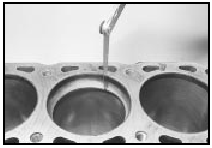Pistons and connecting rods - examination and renovation
1 Examine the pistons for ovality, scoring, and scratches. Check the connecting rods for wear and damage. The connecting rods carry a letter indicating their weight class; all the rods fitted must be of the same class.
2 The gudgeon pins are an interference fit in the connecting rods, and if new pistons are to be fitted to the existing connecting rods, the work should be carried out by a Ford dealer who will have the necessary tooling. Note that the oil splash hole in the connecting rod must be located on the right-hand side of the piston (the arrow on the piston crown faces forwards).
3 If new rings are to be fitted to the existing pistons, expand the old rings over the top of the pistons. The use of two or three old feeler blades will be helpful in preventing the rings dropping into empty grooves. Note that the oil control ring is in three sections.
4 Before fitting the new rings to the pistons, insert them into the cylinder bore and use a feeler blade to check that the end gaps are within the specified limits (see illustration).

33.4 Checking a piston ring gap at the top of the cylinder bore
5 Clean out the piston ring groove using a piece of old piston ring as a scraper. Be careful not to scratch the aluminium surface of the pistons. Protect your fingers - piston ring edges are sharp.
6 Fit the oil control ring sections with the spreader ends abutted opposite the front of the piston. The side ring gaps should be 25 mm (1.0 in) either side of the spreader gap. Fit the tapered lower compression ring with the “TOP” mark towards the top of the piston and the gap 150º from the spreader gap, then fit the upper compression ring with the gap 150º on the other side of the spreader gap. Note that the compression rings are coated with a molybdenum skin which must not be damaged.
Note also that the compression rings are made of cast iron, and will snap if expanded too far.
See also:
Fuel tank - removal and refitting
The procedure is as described in Part A of
this Chapter for carburettor engines. ...
Rear suspension front mounting (Saloon, Hatchback and Estate models) -
renewal
1 Chock the front wheels, jack up the rear of
the vehicle and support on axle stands placed
under the side members.
2 Unscrew and remove the three bolts
securing the relevant front guide plate to ...
Throttle housing - removal and refitting
Note: A new gasket must be used on refitting.
Removal
1 Disconnect the battery negative lead.
2 Depressurise the fuel system as described
in Section 6.
3 Remove the air inlet pipe (see illustrati ...
